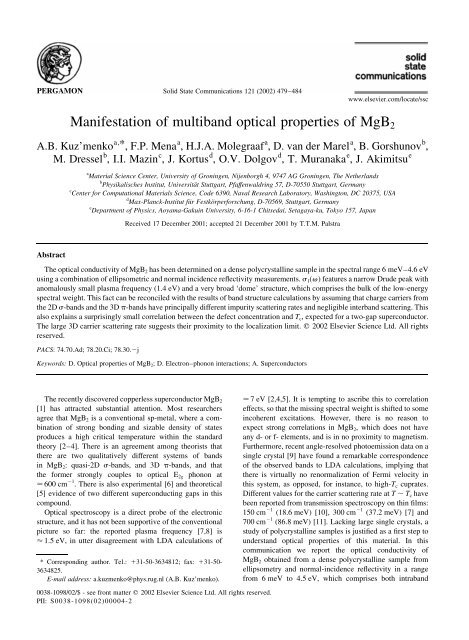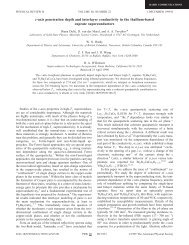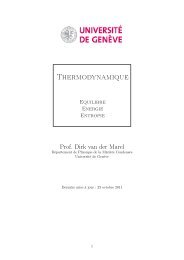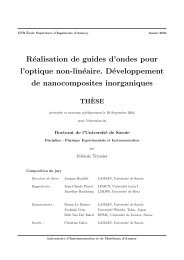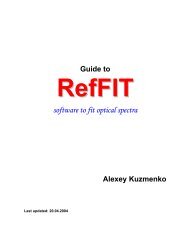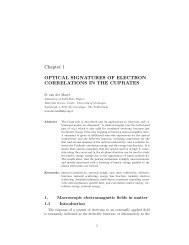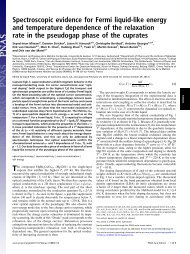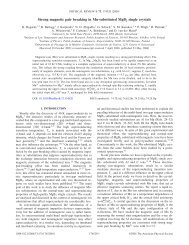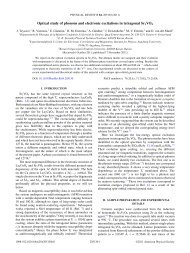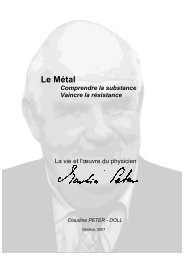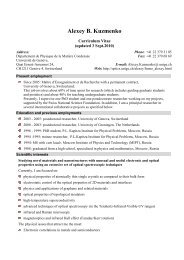Manifestation of multiband optical properties of MgB2
Manifestation of multiband optical properties of MgB2
Manifestation of multiband optical properties of MgB2
Create successful ePaper yourself
Turn your PDF publications into a flip-book with our unique Google optimized e-Paper software.
PERGAMON<br />
<strong>Manifestation</strong> <strong>of</strong> <strong>multiband</strong> <strong>optical</strong> <strong>properties</strong> <strong>of</strong> <strong>MgB2</strong><br />
A.B. Kuz'menko a,*, F.P. Mena a , H.J.A. Molegraaf a , D. van der Marel a , B. Gorshunov b ,<br />
M. Dressel b , I.I. Mazin c , J. Kortus d , O.V. Dolgov d , T. Muranaka e , J. Akimitsu e<br />
Abstract<br />
a Material Science Center, University <strong>of</strong> Groningen, Nijenborgh 4, 9747 AG Groningen, The Netherlands<br />
b Physikalisches Institut, UniversitaÈt Stuttgart, Pfaffenwaldring 57, D-70550 Stuttgart, Germany<br />
c Center for Computational Materials Science, Code 6390, Naval Research Laboratory, Washington, DC 20375, USA<br />
d Max-Planck-Institut fuÈr FestkoÈrperforschung, D-70569, Stuttgart, Germany<br />
e Department <strong>of</strong> Physics, Aoyama-Gakuin University, 6-16-1 Chitsedai, Setagaya-ku, Tokyo 157, Japan<br />
Received 17 December 2001; accepted 21 December 2001 by T.T.M. Palstra<br />
The <strong>optical</strong> conductivity <strong>of</strong> <strong>MgB2</strong> has been determined on a dense polycrystalline sample in the spectral range 6 meV±4.6 eV<br />
using a combination <strong>of</strong> ellipsometric and normal incidence re¯ectivity measurements. s1(v) features a narrow Drude peak with<br />
anomalously small plasma frequency (1.4 eV) and a very broad `dome' structure, which comprises the bulk <strong>of</strong> the low-energy<br />
spectral weight. This fact can be reconciled with the results <strong>of</strong> band structure calculations by assuming that charge carriers from<br />
the 2D s-bands and the 3D p-bands have principally different impurity scattering rates and negligible interband scattering. This<br />
also explains a surprisingly small correlation between the defect concentration and Tc, expected for a two-gap superconductor.<br />
The large 3D carrier scattering rate suggests their proximity to the localization limit. q 2002 Elsevier Science Ltd. All rights<br />
reserved.<br />
PACS: 74.70.Ad; 78.20.Ci; 78.30.2j<br />
Keywords: D. Optical <strong>properties</strong> <strong>of</strong> MgB 2; D. Electron±phonon interactions; A. Superconductors<br />
The recently discovered copperless superconductor MgB 2<br />
[1] has attracted substantial attention. Most researchers<br />
agree that <strong>MgB2</strong> is a conventional sp-metal, where a combination<br />
<strong>of</strong> strong bonding and sizable density <strong>of</strong> states<br />
produces a high critical temperature within the standard<br />
theory [2±4]. There is an agreement among theorists that<br />
there are two qualitatively different systems <strong>of</strong> bands<br />
in MgB 2: quasi-2D s-bands, and 3D p-bands, and that<br />
the former strongly couples to <strong>optical</strong> E2g phonon at<br />
< 600 cm 21 . There is also experimental [6] and theoretical<br />
[5] evidence <strong>of</strong> two different superconducting gaps in this<br />
compound.<br />
Optical spectroscopy is a direct probe <strong>of</strong> the electronic<br />
structure, and it has not been supportive <strong>of</strong> the conventional<br />
picture so far: the reported plasma frequency [7,8] is<br />
< 1.5 eV, in utter disagreement with LDA calculations <strong>of</strong><br />
* Corresponding author. Tel.: 131-50-3634812; fax: 131-50-<br />
3634825.<br />
E-mail address: a.kuzmenko@phys.rug.nl (A.B. Kuz'menko).<br />
Solid State Communications 121 (2002) 479±484<br />
0038-1098/02/$ - see front matter q 2002 Elsevier Science Ltd. All rights reserved.<br />
PII: S0038-1098(02)00004-2<br />
www.elsevier.com/locate/ssc<br />
< 7 eV [2,4,5]. It is tempting to ascribe this to correlation<br />
effects, so that the missing spectral weight is shifted to some<br />
incoherent excitations. However, there is no reason to<br />
expect strong correlations in <strong>MgB2</strong>, which does not have<br />
any d- or f- elements, and is in no proximity to magnetism.<br />
Furthermore, recent angle-resolved photoemission data on a<br />
single crystal [9] have found a remarkable correspondence<br />
<strong>of</strong> the observed bands to LDA calculations, implying that<br />
there is virtually no renormalization <strong>of</strong> Fermi velocity in<br />
this system, as opposed, for instance, to high-Tc cuprates.<br />
Different values for the carrier scattering rate at T , T c have<br />
been reported from transmission spectroscopy on thin ®lms:<br />
150 cm 21 (18.6 meV) [10], 300 cm 21 (37.2 meV) [7] and<br />
700 cm 21 (86.8 meV) [11]. Lacking large single crystals, a<br />
study <strong>of</strong> polycrystalline samples is justi®ed as a ®rst step to<br />
understand <strong>optical</strong> <strong>properties</strong> <strong>of</strong> this material. In this<br />
communication we report the <strong>optical</strong> conductivity <strong>of</strong><br />
MgB 2 obtained from a dense polycrystalline sample from<br />
ellipsometry and normal-incidence re¯ectivity in a range<br />
from 6 meV to 4.5 eV, which comprises both intraband
480<br />
Intensity<br />
and low-energy interband excitations. We also report theoretical<br />
calculation <strong>of</strong> the same quantity, including the<br />
electron±phonon interaction (EPI) and the polycrystalline<br />
nature <strong>of</strong> the sample. We suggest that the intraband conductivity<br />
consists <strong>of</strong> two qualitatively different components: a<br />
narrow Drude peak (DP) due to the s-bands, and an overdamped<br />
DP due to the p-band electrons. The latter scatter so<br />
strongly in our sample that one may expect deviations from<br />
the Drude shape due to localization effects, and indeed we<br />
®nd that the feature in question deviates from the Drude<br />
formula. This model explains naturally a yet unresolved<br />
paradox <strong>of</strong> the two-band scenario [5,12]: the absence <strong>of</strong> a<br />
pair-breaking by paramagnetic impurities, predicted for<br />
two-gap superconductors [13]. In this communication we<br />
concentrate on the broad-range <strong>optical</strong> <strong>properties</strong> keeping<br />
the FIR study <strong>of</strong> the superconducting gap for a separate<br />
publication.<br />
The sample was synthesized from high-purity powdered<br />
A.B. Kuz'menko et al. / Solid State Communications 121 (2002) 479±484<br />
60<br />
40<br />
(a)<br />
20<br />
20<br />
0<br />
0<br />
0<br />
38<br />
100 200<br />
T(K)<br />
40<br />
300<br />
100<br />
101<br />
χ (emu/g)<br />
0.00<br />
-0.02<br />
(b)<br />
FC<br />
ZFC<br />
-0.04<br />
0 20 40<br />
T(K)<br />
(c) MgO<br />
002<br />
110<br />
102<br />
111<br />
*<br />
*<br />
30 40 50 60 70 80 90 100<br />
2θ (deg.)<br />
Fig. 1. The DC resistivity (a), the magnetic susceptibility (b) and the X-ray diffraction (c) <strong>of</strong> the MgB 2 sample.<br />
0.9<br />
0.8<br />
0.7<br />
0 2000 4000<br />
200<br />
201<br />
112<br />
*<br />
103<br />
Mg and B, as described elsewhere [1], and then treated in a<br />
high-pressure BN cell at 1623 K and 5.5 GPa for 30 min<br />
and ®nally quenched to room temperature. A very dense<br />
metallic-like sample was obtained. The T c is about 39 K<br />
with transition width <strong>of</strong> less than 1 K both from the DC<br />
resistivity and the magnetic susceptibility (Fig. 1(a,b)).<br />
The estimated superconducting volume fraction is about<br />
60%. The X-ray diffractometry (Fig. 1(c)) revealed presence<br />
<strong>of</strong> impurity phases which is dif®cult to avoid in a bulk<br />
polycrystalline sample. One can estimate that the sample<br />
contains around 5±7% <strong>of</strong> MgO and about 1% <strong>of</strong> other<br />
phases. The R(300 K)/R(50 K) ratio is 2.2.<br />
The sample was cut and dry-polished with a 0.1 mm<br />
diamond micropolisher. The surface was black and shiny<br />
with an area <strong>of</strong> about 8 mm 2 . Because <strong>of</strong> ellipsometrically<br />
detected changes <strong>of</strong> the <strong>optical</strong> <strong>properties</strong> in air, probably<br />
due to surface oxidation, the sample was inserted into the<br />
cryostat within minutes after polishing to make sure that the<br />
Energy (eV)<br />
0.0<br />
1.0<br />
0.2 0.4 0.6 1 2 3 4 5<br />
40<br />
R 1.00<br />
1.0<br />
15 K<br />
0.95<br />
50 K<br />
300 K<br />
300 K<br />
200 400 600<br />
ε 2<br />
ε 1<br />
R 0.5<br />
Wavenumber (cm -1 )<br />
0.0<br />
0 20000 40000<br />
50 K<br />
300 K<br />
20<br />
10000 20000 30000 40000<br />
-20<br />
Fig. 2. Experimental spectra at 50 K and 300 K: normal re¯ectivity (left) and dielectric function (right). The left inset shows the re¯ectivity in<br />
the FIR range for T ˆ 300; 250, 200, 150, 100, 50 and 15 K (from bottom to top). The right inset shows the re¯ectivity in the full frequency<br />
range (at high frequencies, restored from ellipsometry data). The Drude±Lorentz ®t at 300 K is shown in gray.<br />
0
σ 1 (10 3 Ω -1 cm -1 )<br />
near-surface region corresponds to the bulk <strong>properties</strong>.<br />
Normal-incidence re¯ectivity measurements in polarized<br />
light did not reveal any <strong>optical</strong> anisotropy implying no<br />
preferential grain orientation.<br />
We combined ellipsometry and re¯ection spectroscopy to<br />
determine the <strong>optical</strong> constants for 15 K , T , 300 K. The<br />
dielectric function e ˆ e 1 1 ie 2 was measured directly<br />
using a commercial <strong>optical</strong> ellipsometer with a UHV cryostat<br />
in the range 6000±37,000 cm 21 (0.45±4.6 eV) at the<br />
angle <strong>of</strong> incidence u ˆ 808: The measurements at u ˆ 608<br />
gave almost the same dielectric function, which is also an<br />
indication <strong>of</strong> isotropic <strong>properties</strong> <strong>of</strong> our sample. The normal<br />
incidence re¯ectivity spectra were measured from 20<br />
to 6000 cm 21 (2.5 meV±0.45 eV) utilizing Bruker 113v<br />
FT-IR spectrometer, equipped with a home-design ultrastable<br />
<strong>optical</strong> cryostat. Absolute re¯ectivities for each<br />
temperature were calibrated with the aid <strong>of</strong> a gold ®lm,<br />
deposited in situ on the sample. In this range the complex<br />
re¯ectivity phase was obtained with Kramers±Kronig (KK)<br />
transformation, allowing us to calculate e 1 and e 2. The phase<br />
spectrum was anchored using ellipsometric data at higher<br />
frequencies (see Ref. [14]).<br />
An important issue is the effect <strong>of</strong> impurity phases on the<br />
A.B. Kuz'menko et al. / Solid State Communications 121 (2002) 479±484 481<br />
Energy (eV)<br />
0<br />
10<br />
1 2 3 4 5<br />
8<br />
6<br />
4<br />
2<br />
20 15 K 200 K<br />
15<br />
50 K<br />
100 K<br />
250 K<br />
300 K<br />
10<br />
150 K<br />
5<br />
0<br />
50 K<br />
300 K<br />
250 500 750 1000<br />
0.0<br />
0 1 2 3 4 5<br />
Energy (eV)<br />
0<br />
0 10000 20000 30000<br />
Wavenumber (cm<br />
40000<br />
-1 )<br />
Fig. 3. Optical conductivity at 50 and 300 K determined from the experimental data (as described in the text). The left inset shows the<br />
T-dependence <strong>of</strong> the narrow DP is shown. The right inset: the effective number <strong>of</strong> carriers per cell, Neff(v) (solid curve: 50 K, dashed curve:<br />
300 K).<br />
Table 1<br />
Parameters (in eV) <strong>of</strong> Drude (1, 2) and Lorentz (3±6) peaks<br />
obtained by spectra ®tting at 300 K (e 1 ˆ 2.9)<br />
No. v 0 V p g<br />
1 ± 1.39 0.03<br />
2 ± 4.94 1.16<br />
3 0.29 1.46 0.34<br />
4 0.79 3.35 1.21<br />
5 3.40 4.85 2.40<br />
6 5.23 5.80 1.23<br />
N eff<br />
1.0<br />
0.5<br />
<strong>optical</strong> spectra. The main impurity component is MgO,<br />
which has almost zero <strong>optical</strong> conductivity in the studied<br />
frequency range except for a few sharp phonon peaks in<br />
the FIR range. Using the Maxwell±Garnett theory <strong>of</strong> the<br />
two-component media [15] one can show that the role <strong>of</strong><br />
impurity in this case is to reduce the observed conductivity<br />
uniformly by 7±10% compared to the impurity-free sample.<br />
As impurity concentration is not precisely known, we do not<br />
correct the conductivity for this effect, but keep it in mind in<br />
the discussion.<br />
The experimental spectra are shown in Fig. 2. At high<br />
energies the spectra demonstrate very little T-dependence.<br />
In the IR range the re¯ectivity steadily increases with cooling<br />
down. An additional small superconductivity-related<br />
increase <strong>of</strong> R is observed below Tc for v & 12 meV; in<br />
agreement with earlier data [16]. The main low-frequency<br />
features <strong>of</strong> the <strong>optical</strong> conductivity (Fig. 3) are a narrow DP<br />
with a small spectral weight, and a broad `dome' structure<br />
extending up to 1±1.5 eV. There is a minimum at
482<br />
σ 1 (10 3 Ω -1 cm -1 )<br />
The standard procedure <strong>of</strong> quantifying <strong>optical</strong> spectra is<br />
the Drude±Lorentz data ®tting:<br />
e…v† ˆe 1 2 V 2 p =…v…v 1 ig†† 1 X<br />
i<br />
V 2 pi= v 2 0i 2 v 2 2 ig iv ;<br />
where V p and g are the plasma frequency and the scattering<br />
rate for the DP, and v 0i, V pi and g i are the frequency, the<br />
`plasma' frequency, and the scattering rate <strong>of</strong> the ith Lorentz<br />
oscillator (LO), e 1 is the high-frequency dielectric constant.<br />
We ®tted simultaneously R(v) at low frequencies and both<br />
e 1(v) and e 2(v) at high frequencies (see Fig. 2) with one set<br />
<strong>of</strong> parameters listed in Table 1 for 300 K.<br />
A good ®t can be obtained by introducing two DPs with<br />
very different <strong>properties</strong> (Fig. 4). The narrow DP has an<br />
almost temperature-independent plasma frequency<br />
< 1.4 eV; the temperature dependence <strong>of</strong> the scattering<br />
rate (see inset in Fig. 4) scales well with the r DC(T ) curve<br />
A.B. Kuz'menko et al. / Solid State Communications 121 (2002) 479±484<br />
10<br />
8<br />
6<br />
4<br />
2<br />
Energy (eV)<br />
0 1 2 3 4 5<br />
ω p (eV)<br />
2<br />
1<br />
0 T<br />
0 100 200 300<br />
(K)<br />
0<br />
0 100 200 300<br />
T(K)<br />
0<br />
0 10000 20000 3000 40000<br />
Wavenumber (cm -1 )<br />
Fig. 4. Contributions to the <strong>optical</strong> conductivity in the Drude±Lorentz ®tting at 300 K. The solid line is the experiment, the thick gray line is the<br />
®t; the dashed (dotted) lines show the narrow (broad) DP and all the other curves show different LOs. The insets: temperature dependence <strong>of</strong> the<br />
V p and g for the narrow Drude peak.<br />
σ 1 (10 3 Ω -1 cm -1 )<br />
15<br />
10<br />
5<br />
0<br />
experiment<br />
calculation<br />
γ (meV)<br />
40<br />
20<br />
(Fig. 1(a)). The second DP is anomalously broad (g < 1.1±<br />
1.2 eV). Although its plasma frequency ( < 4.9 eV) is much<br />
larger than that <strong>of</strong> the narrow peak, the latter determines the<br />
major part <strong>of</strong> the static conductivity. The `dome' structure<br />
can be ®tted with a combination <strong>of</strong> a broad DP and two LO<br />
at ,0.3 and ,0.8 eV. Finally, there is another broad peak<br />
centered at ,3.4 eV and a peak at ,5.1 eV.<br />
Let us now compare the data with the ®rst-principles<br />
calculations [2,5]. To account for the polycrystalline sample<br />
texture we averaged the in-plane and out-<strong>of</strong>-plane contributions<br />
to the <strong>optical</strong> conductivity using the effective<br />
medium approximation (EMA) [15] assuming spherical<br />
randomly oriented grains. This approach is more accurate<br />
at low frequencies, where the wavelength l is larger than<br />
the typical grain size d (in our case <strong>of</strong> the order <strong>of</strong> 1±5 mm).<br />
For the limit l q d the re¯ectivity should be averaged<br />
directly rather than conductivity. For highly anisotropic<br />
compounds, e.g. cuprates, it was shown that some arti®cial<br />
Energy (eV)<br />
0 1 2 3 4 5<br />
25<br />
20<br />
15<br />
10<br />
5<br />
in-plane<br />
out-<strong>of</strong>-plane<br />
0<br />
0 5 10<br />
Energy (eV)<br />
15 20<br />
10000 20000 30000 40000<br />
Wavenumber (cm -1 )<br />
Fig. 5. Comparison <strong>of</strong> the experimental and calculated <strong>optical</strong> conductivity, including the interband part shown in the inset, at 300 K (see text).
A.B. Kuz'menko et al. / Solid State Communications 121 (2002) 479±484 483<br />
structures may show up due to re¯ectivity-averaging effect<br />
[17,18]. Although we take such a possibility very seriously,<br />
the fact that the complex dielectric functions obtained by<br />
ellipsometry measurements at incidence angles 60 and 808<br />
match very well is an argument that the concept <strong>of</strong> effective<br />
medium conductivity works suf®ciently well even in the<br />
high-energy part <strong>of</strong> our measured spectral range.<br />
The interband <strong>optical</strong> conductivity (Fig. 5) was calculated<br />
by the WIEN97 LAPW code [19] using the band structure<br />
<strong>of</strong> Ref. [2]. The experimental peak at 0.3 eV clearly corresponds<br />
to the in-plane interband transition between the two<br />
s-bands at 0.35 eV. The broad 3.4 eV peak ®nds no counterpart<br />
in the theory: the closest peak (2.4 eV, in-plane polarization)<br />
stems from the van Hove singularity at the M point.<br />
The reason for this discrepancy is not clear at the moment,<br />
although it might be related to the disorder effects discussed<br />
later. The increase <strong>of</strong> the conductivity above 4 eV, which is<br />
simulated by the LO at 5.1 eV, one can probably associate<br />
with the intensive out-<strong>of</strong>-plane maximum at 4.7 eV due to<br />
charge excitations between the B and Mg planes [20].<br />
The intraband conductivity is particularly interesting.<br />
The calculated in-plane (out-<strong>of</strong>-plane) plasma frequencies<br />
<strong>of</strong> the 2D s-band are 4.1 (0.7) eV, which in the EMA gives<br />
3.0 eV for the effective plasma frequency v ps <strong>of</strong> the s-band.<br />
Similarly, for the p-band, we obtain v pp ˆ 6:2eV: The<br />
total plasma frequency v p is thus expected to be about<br />
6.9 eV.<br />
The observed V p <strong>of</strong> the narrow DP alone (1.4 eV), in<br />
agreement with Refs. [7,8], is much smaller than the calculated<br />
total v p. It can account for only a small part <strong>of</strong> the<br />
expected total spectral weight. However, about 80% <strong>of</strong> the<br />
missing spectral weight can be found in the features forming<br />
the broad `dome' structure. We suggest therefore that the<br />
narrow DP is due to the 2D s-band carriers, while the broad<br />
`dome' is mainly formed by the intraband excitations within<br />
the 3D p-band with some contribution from the low-energy<br />
interband transitions between s-bands. The two orders <strong>of</strong><br />
magnitude difference in the elastic scattering rates for the sand<br />
p-bands can be explained by the principally different<br />
nature <strong>of</strong> the two-band systems. The s-bands have hardly<br />
any weight on Mg, while the p-bands hybridize with Mg<br />
orbitals. On the other hand, the strong covalent bonding in<br />
the B planes makes any defect in this plane energetically<br />
very unfavorable, while the loosely bound Mg planes should<br />
be prone to all kinds <strong>of</strong> defects. This implies that electrons in<br />
the s-bands may experience much less defect scattering<br />
than those in the p-bands.<br />
Even this model cannot fully explain the small plasma<br />
frequency (1.4 eV) <strong>of</strong> the narrow DP, since the calculated<br />
s-band effective plasma frequency is 3 eV. However, an<br />
important piece <strong>of</strong> physics is the mass renormalization due<br />
to strong EPI. This effect is negligible if g q v ph; which is<br />
usually the case in metal optics. In MgB 2, however, the EPI<br />
is believed to come mainly from the E2g phonon with<br />
v ph , 600 cm 21 , larger than the s-band scattering rate. In<br />
this case, the mass renormalization still does not change the<br />
DC resistivity, but the peak gets narrower, and ®tting by the<br />
standard Drude formula produces an v p, which is, compared<br />
to the bare plasma frequency, reduced by a factor m p =m ˆ<br />
1 1 l; where l is the EPI constant [21]. The remaining<br />
spectral weight is transferred to higher energies, v . v ph.<br />
The calculated coupling constants [5] for different bands<br />
are: l 0s ˆ 1:2 and l 0p ˆ 0:45: This renormalizes the<br />
plasma frequency <strong>of</strong> the s-band DP to < 2 eV.<br />
Given such a large scattering rate, is the Drude model<br />
applicable at all to the p-bands? The calculated Fermi<br />
velocity is about 4.9 £ 10 7 cm/s [2] so that the g ˆ 1:1eVˆ<br />
2:7 £ 10 14 s 21 ; results in a mean free path l ˆ v F=g < 18 A;<br />
comparable with the lattice constant. This signals approaching<br />
weak localization <strong>of</strong> charge carriers by defects, as<br />
opposed to Boltzmann transport. The grain boundaries<br />
might introduce additional scattering, however, such a<br />
short mean free path is dif®cult to explain by the grain<br />
effects only. Localization effects should lead to deviations<br />
from the pure Drude formula: an additional suppression <strong>of</strong><br />
conductivity at v ! 0 and a characteristic maximum on<br />
s1(v) curve at frequencies <strong>of</strong> the order <strong>of</strong> the inelastic<br />
scattering rate. This might explain the broad peak at<br />
0.8 eV, which has almost the same g as the broad DP, and<br />
comparable spectral weight (see Table 1). The combination<br />
<strong>of</strong> these two terms might mimic the deformation <strong>of</strong> the<br />
conventional DP due to localization effects.<br />
Fig. 5 shows the effective conductivity (including both<br />
interband and intraband components), obtained from ®rstprinciple<br />
calculations. We calculated the intraband absorption<br />
separately for the s- and p-bands, and included the<br />
frequency-dependent mass renormalizations and scattering<br />
rates due to EPI, as described in Ref. [21]. The EPI<br />
Eliashberg function was taken in the Einstein form:<br />
a 2 s;pF…v† ˆ0:5l 0s;pvd…v 2 v ph†: The values for the T ˆ<br />
0 scattering rates were taken from the experiment: g s ˆ<br />
15 meV; g p ˆ 1:1 eV:<br />
There is a qualitative agreement between the ®rstprinciples<br />
calculations and the experiment, despite a 50%<br />
difference in plasma frequencies. However, without the<br />
two-band scenario the discrepancy would be an order <strong>of</strong><br />
magnitude bigger. The remaining error may be due to one<br />
or more <strong>of</strong> the following: earlier mentioned 7±10% scaling<br />
<strong>of</strong> the conductivity due to ®nite impurity concentration;<br />
surface quality issues; grain boundary and localization<br />
effects; possible underestimation <strong>of</strong> l in the calculations<br />
because <strong>of</strong> nonlinear EPI.<br />
Let us now make a link to superconductivity. Various<br />
experiments indicate that <strong>MgB2</strong> cannot be described by<br />
the standard BCS theory [6]. The popular two-gap theory<br />
[5,12] seems to be able to explain the majority <strong>of</strong> the<br />
experiments. However, it is known [13] that in this case<br />
the interband impurity scattering must rapidly suppress Tc<br />
by isotropization <strong>of</strong> the order parameter. Such a suppression<br />
has not been observed [6], which can be interpreted as a<br />
serious argument against the two-gap model. Our two-<br />
Drude picture <strong>of</strong> the low-energy <strong>optical</strong> conductivity helps
484<br />
to resolve this paradox. Indeed, the existence <strong>of</strong> two distinguishable<br />
DPs would only be possible provided that the<br />
s±p charge scattering is small. In this case impurity scattering,<br />
albeit reducing the DC conductivity, does not isotropize<br />
the gap, therefore the Anderson theorem holds and no pairbreaking<br />
occurs [13].<br />
It is worth noting that one cannot, based just on the ®t<br />
quality, choose between our `two-DP' model and a DL ®t<br />
with the second DP replaced by a broad low-energy …v 0 &<br />
0:25 eV† LO. Although the latter interpretation is consistent<br />
with the data, we favor the two DP model for the following<br />
reasons: (i) the plasma frequency, unlike some other electronic<br />
<strong>properties</strong>, is known to be reproducible by LDA<br />
calculations within errors hardly ever larger than 100%, as<br />
opposed to a factor <strong>of</strong> ®ve discrepancy we would have for<br />
<strong>MgB2</strong> (ii) with one DP the total v p is less than 2 eV; in this<br />
case the application <strong>of</strong> the standard high-T limit <strong>of</strong> the<br />
Bloch±GruÈneisen formula, r DC…T† ˆ8p 2 l trT=v 2 p would<br />
give the EPI transport constant l tr , 0:15 [8], an unphysically<br />
small value for an covalent±ionic metal with a sizeable<br />
density <strong>of</strong> states. Finally, (iii) the two-DP model resolves<br />
naturally the main problem <strong>of</strong> the two-gap superconductivity<br />
model, supported by a variety <strong>of</strong> experiments.<br />
In summary, the <strong>optical</strong> conductivity <strong>of</strong> MgB 2 in a wide<br />
frequency range was obtained using a combination <strong>of</strong><br />
ellipsometry and normal incidence re¯ectometry methods.<br />
The drastic suppression <strong>of</strong> the low-energy spectral weight<br />
®nds a natural explanation in the <strong>multiband</strong> model: a narrow<br />
DP corresponds to the 2D s-bands (additionally renormalized<br />
by the EPI), while the intraband absorption <strong>of</strong> the 3D<br />
p-bands is spread over a large frequency range up to<br />
1±1.5 eV. Optical measurements on high-quality single<br />
crystals <strong>of</strong> MgB 2 are necessary to get more reliable data<br />
on the <strong>optical</strong> conductivity and its anisotropy.<br />
A.B. Kuz'menko et al. / Solid State Communications 121 (2002) 479±484<br />
Acknowledgements<br />
This investigation was supported by the Netherlands<br />
Foundation for Fundamental Research on Matter (FOM)<br />
with ®nancial aid from the Nederlandse Organisatie voor<br />
Wetenschappelijk Onderzoek (NWO). We thank R.K.<br />
Kremer for performing the succeptibility measurements.<br />
References<br />
[1] J. Nagamatsu, et al., Nature 410 (2001) 63.<br />
[2] J. Kortus, et al., Phys. Rev. Lett. 86 (2001) 4656.<br />
[3] J.M. An, W.E. Pickett, Phys. Rev. Lett. 86 (2001) 4366.<br />
[4] Y. Kong, et al., Phys. Rev. B 64 (2001) 20501.<br />
[5] A.Y. Liu, I.I. Mazin, J. Kortus, Phys. Rev. Lett. 87 (2001)<br />
087005.<br />
[6] C. Buzea, T. Yamashita, cond-mat/0108265, 2001.<br />
[7] R.A. Kaindl, cond-mat/0106342.<br />
[8] J.J. Tu, et al., cond-mat/0107349.<br />
[9] H. Uchiyama, et al., cond-mat/0111152.<br />
[10] A.V. Pronin, et al., Phys. Rev. Lett. 87 (2001) 097003.<br />
[11] J.H. Jung, et al., cond-mat/0105180.<br />
[12] S.V. Shulga, et al., cond-mat/0103154.<br />
[13] A.A. Golubov, I.I. Mazin, Phys. Rev. B55 (1997) 15146.<br />
[14] J.W. van der Eb, A.B. Kuz'menko, D. van der Marel, Phys.<br />
Rev. Lett. 86 (2001) 3407.<br />
[15] D. Stroud, Phys. Rev. B 12 (1975) 3368.<br />
[16] B. Gorshunov, et al., Eur. J. Phys. B 21 (2001) 159.<br />
[17] I.I. Mazin, et al., JETP Lett. 47 (1988) 113.<br />
[18] J. Orenstein, D.H. Rapkine, Phys. Rev. Lett. 60 (1988) 968.<br />
[19] R. Abt, C. Ambrosch-Draxl, OPTIC codes (part <strong>of</strong> the<br />
WIEN97 package).<br />
[20] W. Ku, et al., cond-mat/0105389.<br />
[21] O.V. Dolgov, S.V. Shulga, J. Supercond. 8 (1995) 611.


